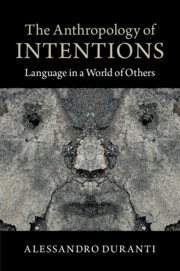Book contents
- Frontmatter
- Contents
- List of figures
- Acknowledgments
- 1 Rethinking anti-intentionalism
- 2 Intentions in speaking and acting: the Standard Theory and its foes
- 3 The avoidance of intentional discourse: a Samoan case study
- 4 The invention of promising in the Samoan translation of the Bible
- 5 Intentionality and truth, revisited
- 6 Speaker intentions and the role of the audience in a political campaign in the US
- 7 A dialogue on intentions
- 8 Opacity of other minds: local theories revisited
- 9 Intentions and their modifications: a lesson from Husserl
- 10 A sense of the other: from intentionality to intersubjectivity
- 11 The intentional continuum
- Appendix A Transcription conventions for English examples
- Appendix B Transcription conventions and abbreviations used in the Samoan examples
- Notes
- References
- Index
4 - The invention of promising in the Samoan translation of the Bible
Published online by Cambridge University Press: 18 December 2014
- Frontmatter
- Contents
- List of figures
- Acknowledgments
- 1 Rethinking anti-intentionalism
- 2 Intentions in speaking and acting: the Standard Theory and its foes
- 3 The avoidance of intentional discourse: a Samoan case study
- 4 The invention of promising in the Samoan translation of the Bible
- 5 Intentionality and truth, revisited
- 6 Speaker intentions and the role of the audience in a political campaign in the US
- 7 A dialogue on intentions
- 8 Opacity of other minds: local theories revisited
- 9 Intentions and their modifications: a lesson from Husserl
- 10 A sense of the other: from intentionality to intersubjectivity
- 11 The intentional continuum
- Appendix A Transcription conventions for English examples
- Appendix B Transcription conventions and abbreviations used in the Samoan examples
- Notes
- References
- Index
Summary
To breed an animal with the right to make promises – is not this the paradoxical problem nature has set itself with regard to man? And is it not man’s true problem?
(Friederich Nietzsche, The Genealogy of Morals, Second Essay)[Morality] has, at least politically, no more to support itself than the good will to counter the enormous risks of action by readiness to forgive and to be forgiven, to make promises and to keep them.
(Hannah Arendt, The Human Condition)Is promising a human universal?
In the typology of speech acts proposed by Austin (1962) first and then further developed by Searle (1969, 1976), promising was a key example of a commissive – that is, a type of act whereby we commit to doing something (like the acts expressed by the English verbs commit, threaten, vow, pledge, offer, bid, warrant). Such commissives, as discussed in Chapter 2, have among their “felicity conditions” (for Austin) or “conditions of satisfaction” (for Searle) the speaker’s intention to do a number of things, namely, (a) carry out the act, (b) accept responsibility for such an act, (c) be under the obligation of doing it, and (d) convince the hearer that (a), (b), and (c) will be the case by using conventional language that will allow the hearer to fully understand what the speaker is up to.
The act of promising played an important role in Michelle Rosaldo’s (1982) argument that speech act theorists were Anglo- and Eurocentric. Her claim that among the Ilongots there was no notion of promise, or at least not in the sense of an act whose conditions of satisfaction are in the privacy of people’s mind or in their “psychological orientation” (1982: 212), was part of a more general trend in the anthropology of the late 1970s and early 1980s.
- Type
- Chapter
- Information
- The Anthropology of IntentionsLanguage in a World of Others, pp. 69 - 100Publisher: Cambridge University PressPrint publication year: 2015



